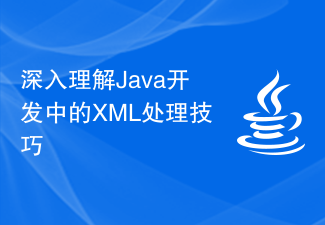 Backend Development
Backend Development PHP Tutorial
PHP Tutorial Best practices for implementing HTML/XML parsing and processing in PHP
Best practices for implementing HTML/XML parsing and processing in PHP
Best Practices for Implementing HTML/XML Parsing and Processing in PHP
Overview:
In web development, it is often necessary to process and parse HTML or XML document. As a popular server-side scripting language, PHP provides a wealth of tools and function libraries that can easily implement HTML/XML parsing and processing. This article will introduce the best practices for HTML/XML parsing and processing in PHP and provide some code examples.
1. Use built-in functions for HTML parsing
PHP provides multiple built-in functions for HTML parsing, the most commonly used of which are:
- file_get_contents: used for reading HTML file content.
- strip_tags: used to remove HTML tags.
- htmlspecialchars: used to convert special characters into HTML entities.
Code example 1: Use file_get_contents to read HTML file content
$html = file_get_contents('example.html');
echo $html;Code example 2: Use strip_tags to remove HTML tags
$html = '<h1 id="Hello-World">Hello, World!</h1><p>This is an example.</p>'; $plainText = strip_tags($html); echo $plainText;
Code example 3: Use htmlspecialchars to convert Special characters
$text = 'This is some <b>bold</b> text.'; $encodedText = htmlspecialchars($text); echo $encodedText;
2. Use extension libraries for advanced HTML/XML parsing
In addition to built-in functions, PHP also provides multiple extension libraries for advanced HTML/XML parsing and processing. The most commonly used ones are:
- DOMDocument: used to create, modify and query HTML/XML documents.
- SimpleXML: Used to parse and process simple XML documents.
Code example 4: Use DOMDocument to query HTML elements
$html = '<h1 id="Hello-World">Hello, World!</h1><p>This is an example.</p>';
$dom = new DOMDocument;
$dom->loadHTML($html);
$element = $dom->getElementsByTagName('h1')->item(0);
echo $element->nodeValue;Code example 5: Use SimpleXML to parse XML documents
$xml = <<<XML <root> <name>John Doe</name> <age>30</age> </root> XML; $simplexml = simplexml_load_string($xml); $name = $simplexml->name; $age = $simplexml->age; echo $name, ' is ', $age, ' years old.';
3. Processing special features in HTML/XML Situation
In actual HTML/XML parsing processing, some special situations may be encountered, requiring additional processing and conversion.
- Processing namespaces
If you want to process an XML document containing a namespace, you need to use the corresponding function or method to process the namespace.
Code example 6: Processing namespace
$xml = <<<XML
<root xmlns:ns="http://example.com">
<ns:name>John Doe</ns:name>
<ns:age>30</ns:age>
</root>
XML;
$simplexml = simplexml_load_string($xml);
$simplexml->registerXPathNamespace('ns', 'http://example.com');
$names = $simplexml->xpath('//ns:name');
foreach ($names as $name) {
echo $name;
}- Processing attributes
If you want to process the attributes of HTML/XML tags, you need to use the corresponding methods to obtain and modify them Attributes.
Code example 7: Processing HTML tag attributes
$html = '<a href="http://example.com">Link</a>';
$dom = new DOMDocument;
$dom->loadHTML($html);
$element = $dom->getElementsByTagName('a')->item(0);
$href = $element->getAttribute('href');
echo $href;Conclusion:
Through PHP's built-in functions and extension libraries, we can easily implement HTML/XML parsing and processing. In actual applications, appropriate methods and functions are selected for processing according to specific needs and scenarios. By mastering the best practices for HTML/XML parsing and processing, you can improve development efficiency and achieve more flexible and reliable web applications.
The above is the detailed content of Best practices for implementing HTML/XML parsing and processing in PHP. For more information, please follow other related articles on the PHP Chinese website!
 能否用PowerPoint打开XML文件Feb 19, 2024 pm 09:06 PM
能否用PowerPoint打开XML文件Feb 19, 2024 pm 09:06 PMXML文件可以用PPT打开吗?XML,即可扩展标记语言(ExtensibleMarkupLanguage),是一种被广泛应用于数据交换和数据存储的通用标记语言。与HTML相比,XML更加灵活,能够定义自己的标签和数据结构,使得数据的存储和交换更加方便和统一。而PPT,即PowerPoint,是微软公司开发的一种用于创建演示文稿的软件。它提供了图文并茂的方
 Java中如何使用JSoup函数进行HTML解析Jun 26, 2023 pm 01:41 PM
Java中如何使用JSoup函数进行HTML解析Jun 26, 2023 pm 01:41 PMHTML是网页的基础表示形式。如果你想在Java中获取并操作HTML文档的内容,你需要使用一个开源的解析工具,如JSoup函数。JSoup是一个用于处理HTML文档的Java库,它提供了一个十分简便的方式来从HTML文档中提取特定的数据和元素。本文将介绍JSoup在Java中的使用。导入JSoup首先,你需要在Java项目中导入JSoup库。你可以在Mave
 如何使用Python正则表达式进行XML处理Jun 23, 2023 am 09:34 AM
如何使用Python正则表达式进行XML处理Jun 23, 2023 am 09:34 AM在日常的数据处理场景中,不同格式的数据处理需要不同的解析方式。对于XML格式的数据,我们可以使用Python中的正则表达式进行解析。本文将介绍使用Python正则表达式进行XML处理的基本思路和方法。XML基础介绍XML(ExtensibleMarkupLanguage)是一种用于描述数据的标记语言,它提供了一种结构化的方法来表示数据。XML的一个重要特
 从HTML页面中提取数据的几种方法Jun 13, 2023 am 10:40 AM
从HTML页面中提取数据的几种方法Jun 13, 2023 am 10:40 AMHTML页面是互联网页面中最常见的一种,它以标记语言的形式进行编写,其中包括许多的标记和元素。在许多情况下,我们需要从HTML页面中提取数据,这样才能对页面进行正确的分析、管理和处理。本文将介绍一些从HTML页面中提取数据的方法,以帮助读者轻松地完成这项任务。一、使用正则表达式正则表达式是文本处理中常用的一种工具,也是从HTML页面中提取数据的最基本的方法之
 PHP API开发中的如何处理XML和JSON格式数据Jun 17, 2023 pm 06:29 PM
PHP API开发中的如何处理XML和JSON格式数据Jun 17, 2023 pm 06:29 PM在现代软件开发中,许多应用程序都需要通过API(应用程序接口)进行交互,允许不同的应用程序之间进行数据共享和通信。在PHP开发中,API是一种常见的技术,让PHP开发人员能够与其他系统集成,并使用不同的数据格式。在本文中,我们将探讨如何在PHPAPI开发中处理XML和JSON格式数据。XML格式数据处理XML(可扩展标记语言)是一种常用的数据格式,用于在不
 HTML中固定定位无法使用的原因的分析Dec 28, 2023 pm 02:17 PM
HTML中固定定位无法使用的原因的分析Dec 28, 2023 pm 02:17 PMHTML是一种用于构建网页的标记语言,它提供了丰富的标签和属性,可以实现各种网页布局效果。其中,固定定位是一种常用的布局方式,它可以让元素相对于浏览器窗口或父元素固定位置显示,不受滚动影响。然而,并非所有的HTML元素都支持固定定位,本文将解析HTML中不支持固定定位的原因,并提供具体的代码示例。首先,我们需要了解固定定位的语法。在HTML中,使用CSS样式
 完全教程:如何使用php扩展SimpleXML处理XML数据Jul 30, 2023 am 10:29 AM
完全教程:如何使用php扩展SimpleXML处理XML数据Jul 30, 2023 am 10:29 AM完全教程:如何使用PHP扩展SimpleXML处理XML数据简介:在Web开发中,处理XML数据是一个常见的任务。PHP提供了许多内置的XML处理工具,其中最常用的是SimpleXML扩展。SimpleXML提供了一种简单而直观的方式来解析和操作XML数据。本教程将介绍如何使用SimpleXML扩展来处理XML数据,包括解析XML、访问和修改节点,以及将XM
 深入理解Java开发中的XML处理技巧Nov 20, 2023 am 08:51 AM
深入理解Java开发中的XML处理技巧Nov 20, 2023 am 08:51 AM深入理解Java开发中的XML处理技巧在现代软件开发中,XML(可扩展标记语言)已成为一种非常常见的数据交换和配置文件格式。Java作为一种广泛使用的编程语言,提供了丰富的API和工具来处理XML文件。在本文中,我们将深入探讨Java开发中的XML处理技巧,以帮助开发人员更好地理解和应用XML。一、XML的基本概念XML是一种用于描述数据的标记语言,它使用标


Hot AI Tools

Undresser.AI Undress
AI-powered app for creating realistic nude photos

AI Clothes Remover
Online AI tool for removing clothes from photos.

Undress AI Tool
Undress images for free

Clothoff.io
AI clothes remover

AI Hentai Generator
Generate AI Hentai for free.

Hot Article

Hot Tools

Dreamweaver Mac version
Visual web development tools

MantisBT
Mantis is an easy-to-deploy web-based defect tracking tool designed to aid in product defect tracking. It requires PHP, MySQL and a web server. Check out our demo and hosting services.

PhpStorm Mac version
The latest (2018.2.1) professional PHP integrated development tool

SublimeText3 Chinese version
Chinese version, very easy to use

mPDF
mPDF is a PHP library that can generate PDF files from UTF-8 encoded HTML. The original author, Ian Back, wrote mPDF to output PDF files "on the fly" from his website and handle different languages. It is slower than original scripts like HTML2FPDF and produces larger files when using Unicode fonts, but supports CSS styles etc. and has a lot of enhancements. Supports almost all languages, including RTL (Arabic and Hebrew) and CJK (Chinese, Japanese and Korean). Supports nested block-level elements (such as P, DIV),






